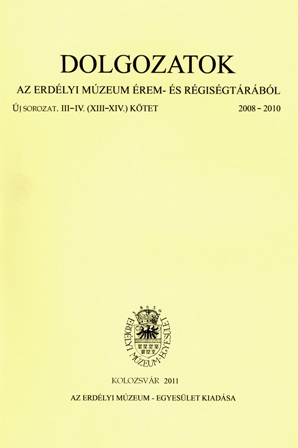„Hozott a legatus második expediciojából”
”Brought from the Emissary’s Second Expedition"
A Case Study about the Practice of Distressed Circuit
Author(s): Mária Márta KovácsSubject(s): History, Cultural history, Economic history, Social history, 18th Century
Published by: Erdélyi Múzeum-Egyesület
Keywords: distressed circuit; Transylvanian Reformed Diocese; holy communion; 18th century; Hunyad-Zaránd parish
Summary/Abstract: We get more familiar with the subsequent details of the Transylvanian Reformed Diocese assembly’s resources, together with the subsistence of the holy communions service since the 18th century general practice, and least but not lastly the distressed circuit’s modus operandi. The assemblies in the cases of bigger mischief or expenses, not only drew on slush-funds from the members of the parish, but they asked for the subservience of parishes in a narrower and broader apprehension. The present study undertakes, among the only ones, the analysis of the influence on the gathering trips of relics’, which is presented through the Kézdimátisfalva (Mătiseni) parish’s service reminiscence and archive sources. Usually the gathering trips’ turn came with the building operations and rectification of churches, but in the case of fire or war destruction, the parishes’ patrons and assemblies, past to bounties, helped the deadbeats with vessels and textiles. The synod has determined the donation circuit’s legitimate proceedings for several times, the deadbeat letter had been displayed by the Gubernium with the intervention of the Consistorium Supremum. In the reformed parishes did not evolve rich collections, because the assembly’s vessels that were beyond usage had been appropriated to the poorer ecclesiasts. With the help of some data about the inventories and services known by me, I succeeded in justifying the intervention of distress in several assemblies – primarily in the second half of the 18th centuries’ Hunyad-Zaránd parishes that have been plundered for several times. During the 1778 fire, the service of the Kézdimátisfalva church had been significantly damaged, that time the relic-chest together with the relics in it, belonging to the caretaker, completely burned down. In the first half of 1779, there had been taken place two gathering trips, the emissary being Keresztes Ferenc at both times. We do not know the period of the first circuit, but going by the donation, it must have weltered in the Hunyad-Zaránd Diocese, in the outskirts of Déva (Deva), where, from the parishes (Déva) and form the donations of noble families (Barcsai, Kun, Naláczi), have been gathered a very rich service. In April 1779, Keresztes Ferenc from Márkosfalva (Mărcușa), has gone to a charity trip, that time in the Maros Diocese, which is confirmed by the donation of Toldalagi Pál. Throughout the gathering trips, the footed beaker and silver plates, that were in the property of the church, had lasted to the present day, just like the fire-survivor tin flacon, or the tin tankard, tin plate and the hexagonal tin flacon, that were a donation after the ravage.
Journal: Dolgozatok az Erdélyi Múzeum Érem- és Régiségtárából. Új sorozat
- Issue Year: 2010
- Issue No: III-V
- Page Range: 223-235
- Page Count: 13
- Language: Hungarian

